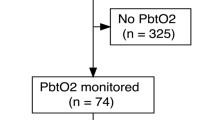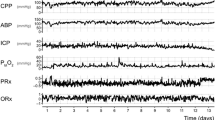Abstract
Purpose
Cerebral tissue oxygenation (PbrO2) is most frequently monitored using a Licox CC1.SB system (LX, Integra Neuroscience, France) but recently a new probe—the Neurovent-PTO (NV)—was introduced by a different manufacturer (Raumedic, Germany). There are no prospective data on how these probes compare in clinical routine. We therefore compared both probes in comatose patients suffering from traumatic brain injury (TBI) or subarachnoid haemorrhage (SAH) during dynamic changes of inspirational oxygen fraction (FiO2) and mean arterial pressure (MAP).
Methods
PbrO2 in 11 patients was recorded continuously using an LX and NV probe placed side by side into the same cerebrovascular region. Once a steady baseline value was reached FiO2 was increased by 20% for 10 min. Once the baseline values were re-established MAP was increased by 20 mmHg for 10 min. Evaluation was performed using a four-parameter logistic function and Bland–Altman analyses.
Results
PbrO2 values of both probes differed significantly at all times. The LX probe reacted significantly faster to changes in FiO2 and MAP. Limits of agreement ranged between −32.1 and 20.0 mmHg. Mean LX values were 6.1 mmHg lower than NV values.
Conclusions
Since the examined patient cohort was rather small, this study’s results are preliminary. However, they suggest that LX and NV probes measure different PbrO2 values in routine monitoring as well as during phases of dynamic changes in FiO2 and MAP. These data therefore do not support the view that both probes can be used interchangeably.




Similar content being viewed by others
References
van Gijn J, Kerr RS, Rinkel GJ (2007) Subarachnoid haemorrhage. Lancet 369:306–318
Nieuwkamp DJ, Setz LE, Algra A, Linn FH, de Rooij NK, Rinkel GJ (2009) Changes in case fatality of aneurysmal subarachnoid haemorrhage over time, according to age, sex, and region: a meta-analysis. Lancet Neurol 8:635–642
Jaeger M, Schuhmann MU, Soehle M, Meixensberger J (2006) Continuous assessment of cerebrovascular autoregulation after traumatic brain injury using brain tissue oxygen pressure reactivity. Crit Care Med 34:1783–1788
Jaeger M, Schuhmann MU, Soehle M, Nagel C, Meixensberger J (2007) Continuous monitoring of cerebrovascular autoregulation after subarachnoid hemorrhage by brain tissue oxygen pressure reactivity and its relation to delayed cerebral infarction. Stroke 38:981–986
Dings J, Meixensberger J, Amschler J, Roosen K (1996) Continuous monitoring of brain tissue PO2: a new tool to minimize the risk of ischemia caused by hyperventilation therapy. Zentralbl Neurochir 57:177–183
Maas AI, Fleckenstein W, de Jong DA, van Santbrink H (1993) Monitoring cerebral oxygenation: experimental studies and preliminary clinical results of continuous monitoring of cerebrospinal fluid and brain tissue oxygen tension. Acta Neurochir Suppl (Wien) 59:50–57
Valadka AB, Gopinath SP, Contant CF, Uzura M, Robertson CS (1998) Relationship of brain tissue PO2 to outcome after severe head injury. Crit Care Med 26:1576–1581
Purins K, Enblad P, Sandhagen B, Lewén A (2005) Brain tissue oxygen monitoring: a study of in vitro accuracy and stability of Neurovent-PTO and Licox sensors. Acta Neurochir (Wien) 152:681–688
Orakcioglu B, Sakowitz OW, Neumann JO, Kentar MM, Unterberg A, Kiening KL (2010) Evaluation of a novel brain tissue oxygenation probe in an experimental swine model. Neurosurgery 67:1716–1722
Huschak G, Hoell T, Hohaus C, Kern C, Minkus Y, Meisel HJ (2009) Clinical evaluation of a new multiparameter neuromonitoring device: measurement of brain tissue oxygen, brain temperature, and intracranial pressure. J Neurosurg Anesthesiol 21:155–160
The R Project for Statistical Computing (2010) R 2.11.1. http://www.r-project.org. Accessed 12 January 2010
Pinheiro J, Bates D (2009) Mixed-effects models in S and S-PLUS, 2nd edn. Springer, New York
Akaike H (1974) A new look at the statistical model identification. IEEE Trans Autom Contr 19:716–723
Bland JM, Altman DG (1986) Statistical methods for assessing agreement between two methods of clinical measurement. Lancet 8476:307–310
Myles PS, Cui J (2007) Using the Bland–Altman method to measure agreement with repeated measures. Br J Anaesth 99:309–311
Bland JM, Altman DG (2007) Agreement between methods of measurement with multiple observations per individual. J Biopharm Stat 17:571–582
Radolovich DK, Czosnyka M, Timofeev I, Lavinio A, Hutchinson P, Gupta A, Pickard JD, Smielewski P (2009) Reactivity of brain tissue oxygen to change in cerebral perfusion pressure in head injured patients. Neurocrit Care 10:274–279
Jaeger M (2010) Different indices to assess cerebrovascular autoregulation have different dynamic properties. Neurocrit Care 13:163–165
Critchley LA, Critchley JA (1999) A meta-analysis of studies using bias and precision statistics to compare cardiac output measurement techniques. J Clin Monit Comput 15:85–91
Kiening KL, Unterberg AW, Bardt TF, Schneider GH, Lanksch WR (1996) Monitoring of cerebral oxygenation in patients with severe head injuries: brain tissue PO2 versus jugular vein oxygen saturation. J Neurosurg 85:751–757
Meixensberger J, Jaeger M, Väth A, Dings J, Kunze E, Roosen K (2003) Brain tissue oxygen guided treatment supplementing ICP/CPP therapy after traumatic brain injury. J Neurol Neurosurg Psychiatry 74:760–764
Spiotta AM, Stiefel MF, Gracias VH, Garuffe AM, Kofke WA, Maloney-Wilensky E, Troxel AB, Levine JM, Le Roux PD (2010) Brain tissue oxygen-directed management and outcome in patients with severe traumatic brain injury. J Neurosurg 113:571–580
Acknowledgments
The study was exclusively funded by the Department of Neurosurgery of the Charité, Berlin.
Conflict of interest
The authors are not subject to any conflict of interest.
Author information
Authors and Affiliations
Corresponding author
Appendix
Appendix
For modelling the time course of PbrO2 during an intervention, a four-parameter logistic function according to Pinheiro and Bates [12] was used in the following modified form:
Parameters in this exponential function are:
-
PbrO2,start, the asymptotic starting value at the beginning of an intervention.
-
PbrO2,change, the asymptotic change reached at the end of an intervention.
-
t 0.5, the time at the inflection point of the curve at midway between the asymptotes.
-
Φ, a scale parameter measured in seconds on the time axis. When the time (t) after the start of the intervention equals t 0.5 + Φ, the response is PbrO2,change/(1 + e−1) or 0.7310586 × PbrO2,change, roughly three-quarters of the change in PbrO2. Higher values of Φ indicate a slower change in PbrO2.
Rights and permissions
About this article
Cite this article
Dengler, J., Frenzel, C., Vajkoczy, P. et al. Cerebral tissue oxygenation measured by two different probes: challenges and interpretation. Intensive Care Med 37, 1809–1815 (2011). https://doi.org/10.1007/s00134-011-2316-z
Received:
Accepted:
Published:
Issue Date:
DOI: https://doi.org/10.1007/s00134-011-2316-z




